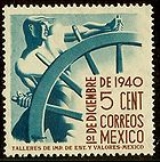
Art Deco stamps
Encyclopedia
Art deco stamps are postage stamp
s designed in the Art Deco
style which was a popular international design style in the 1920s through the 1930s. The style is marked by the use of "geometric motifs, curvilinear forms, sharply defined outlines, often bold colors", and a fascination with machinery and modernity. This style strongly influenced contemporary architecture, furniture, industrial design, books and posters. Art Deco was named for the 1925 exhibit in Paris called Exposition Internationale des Arts Décoratifs et Industriels Modernes
(International Exposition of Modern Industrial and Decorative Arts). The exhibit lasted from April to October 1925 and displayed numerous objects in the new style. Examples of the style, however, are also found in the early twenties.
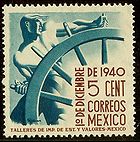 The Art Deco style also influenced postage stamp design in a number of countries in the twenties and thirties. One of the focuses of Art Deco was transportation and machines, particularly airplanes, and airmail stamps of the period often were designed in this style. Stamps from some countries showed strong art deco influence, while in others it was absent or barely noticeable. The countries whose stamp designs were most influenced by Art Deco include a number of European countries such as France and the Netherlands, as well as several Latin American countries, particularly Mexico, Brazil and Chile. Stamps of the United States and Great Britain, in contrast, followed traditional design and showed little influence of this new style.
The Art Deco style also influenced postage stamp design in a number of countries in the twenties and thirties. One of the focuses of Art Deco was transportation and machines, particularly airplanes, and airmail stamps of the period often were designed in this style. Stamps from some countries showed strong art deco influence, while in others it was absent or barely noticeable. The countries whose stamp designs were most influenced by Art Deco include a number of European countries such as France and the Netherlands, as well as several Latin American countries, particularly Mexico, Brazil and Chile. Stamps of the United States and Great Britain, in contrast, followed traditional design and showed little influence of this new style.
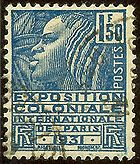
 A triangular airmail stamp issued in 1933, depicting a Fokker
A triangular airmail stamp issued in 1933, depicting a Fokker
Pander, was surrounded by a border with bold lettering typical of the style. In 1934, Curaçao
, then a colony of the Netherlands, issued one of the iconic Art Deco stamps ever created, an airmail stamp carrying the highly stylized profile of the messenger god Hermes
.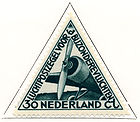
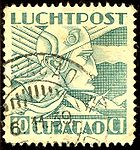
Austrian stamps of the 1920s showed influence of the Jugendstil or Art Nouveau
style, but the new style made its influence known as the decade progressed. In 1925, Austria began a series of postage due stamps
, and which included the country's name and an amount in a simple, bold design.
In 1932, Switzerland issued a stamp honoring the 1932 Disarmament Conference, and depicting an image of Peace in a bold Art Deco style
In 1936, Portugal issued a series of airmail stamps with a highly stylized airplane propeller and cloud, forming a fine Art Deco image.
In the early 1940s, Mexico issued a number of stamps, commonly a larger format with strongly Art Deco influenced images particularly including the artwork of Mexican artist Francisco Eppens
. A 1939 stamp with an image by Eppens depicted three modes of transportation -- airplane, train and highway, a common Art Deco subject. A 1940 stamp by Eppens shows a helmsman, issued in connection with the Inauguration of Mexican President Manuel Avila Camacho
. A 1942 stamp, part of a series honoring the Second Inter-American Agricultural Conference with Eppens' artwork, depicts a highly stylized woman sewing wheat.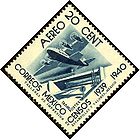

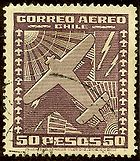
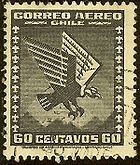
During the 1930s, Brazil issued a number of stamps influenced by the Art Deco style, especially in their lettering. The most striking Art Deco stamps, however, was the 1934 issue commemorating the 7th International Trade Fair, held in Rio de Janeiro
, and depicting silhouettes of buildings and a profile of a construction worker with highly stylized Art Deco lettering.
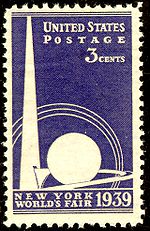 The 1939 stamp depicting the Trylon and Perisphere, the centerpiece and symbol of the 1939 New York World's Fair
The 1939 stamp depicting the Trylon and Perisphere, the centerpiece and symbol of the 1939 New York World's Fair
. Although the Trylon and Perisphere itself is an iconic Art Deco image, the lettering and numbers on the stamp were done in a traditional, not Art Deco, font. With this limited exception, United States stamps showed no Art Deco influence until 1998 when it issued a stamp in a strong Art Deco depicting Ayn Rand.
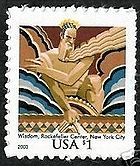
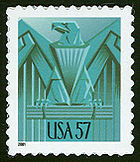 The Art Deco style has been revived on stamps. In 1998, the United States issued a stamp honoring Ayn Rand
The Art Deco style has been revived on stamps. In 1998, the United States issued a stamp honoring Ayn Rand
in a distinct Art Deco style. In 2001, it issued two definitive stamp
s depicting a strongly Art Deco eagle on a mailbox, shown left. In 2003, it issued a stamp honoring Rockefeller Center
, shown right.
Postage stamp
A postage stamp is a small piece of paper that is purchased and displayed on an item of mail as evidence of payment of postage. Typically, stamps are made from special paper, with a national designation and denomination on the face, and a gum adhesive on the reverse side...
s designed in the Art Deco
Art Deco
Art deco , or deco, is an eclectic artistic and design style that began in Paris in the 1920s and flourished internationally throughout the 1930s, into the World War II era. The style influenced all areas of design, including architecture and interior design, industrial design, fashion and...
style which was a popular international design style in the 1920s through the 1930s. The style is marked by the use of "geometric motifs, curvilinear forms, sharply defined outlines, often bold colors", and a fascination with machinery and modernity. This style strongly influenced contemporary architecture, furniture, industrial design, books and posters. Art Deco was named for the 1925 exhibit in Paris called Exposition Internationale des Arts Décoratifs et Industriels Modernes
Exposition Internationale des Arts Décoratifs et Industriels Modernes
The International Exposition of Modern Industrial and Decorative Arts was a World's fair held in Paris, France, from April to October 1925. The term "Art Deco" was derived by shortening the words Arts Décoratifs, in the title of this exposition, but not until the late 1960s by British art critic...
(International Exposition of Modern Industrial and Decorative Arts). The exhibit lasted from April to October 1925 and displayed numerous objects in the new style. Examples of the style, however, are also found in the early twenties.

Notable Art Deco stamps
The Art Deco style originally developed in Europe and the earliest Art Deco stamps are from European countries in the 1920s. The style was used in some Latin American countries beginning in the mid-1930s, but never really spread to the United States, whose stamp designs remained traditional and conservative. Notable Art Deco stamps of this period include the following, some of which are small masterpieces of this style:Europe

- France. In 1925, France issued a set of stamps to commemorate the Exposition Internationale des Arts Décoratifs et Industriels Modernes. The Paris Exposition Coloniale Internationale of 1931Paris Colonial ExpositionThe Paris Colonial Exhibition was a six-month colonial exhibition held in Paris, France in 1931 that attempted to display the diverse cultures and immense resources of France's colonial possessions.-History :The exposition opened on 6 May 1931 in the Bois de Vincennes on the eastern outskirts of...
also was commemorated with a set, including a fine art deco image of the head of an African woman under which was block lettering within ruled lines, a common Art Deco device.
- Germany. In 1925, Germany issued a stamp displaying a bold Art Deco "traffic wheel" or traffic circle, in commemoration of the Deutsche Verkehrausstellung München 1925 or Munich Transport Exhibition of 1925. In 1934, it issued another striking image, two hands grasping a piece of coal, referring to the Saar Plebiscite held the following year which would determine that the coal-rich region would reunite with Germany.
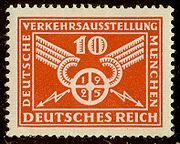

- The Netherlands. The stamps of the Netherlands ahowed influence of the Art Deco style as early as the mid-1920s, when the country issued two stamps honoring the Centenary of the Dutch Lifeboat Society. The stamps depicted highly stylized boats in distress and a lifeboat, with lettering showing some influence of the style.
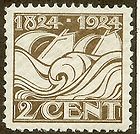

Fokker
Fokker was a Dutch aircraft manufacturer named after its founder, Anthony Fokker. The company operated under several different names, starting out in 1912 in Schwerin, Germany, moving to the Netherlands in 1919....
Pander, was surrounded by a border with bold lettering typical of the style. In 1934, Curaçao
Curaçao
Curaçao is an island in the southern Caribbean Sea, off the Venezuelan coast. The Country of Curaçao , which includes the main island plus the small, uninhabited island of Klein Curaçao , is a constituent country of the Kingdom of the Netherlands...
, then a colony of the Netherlands, issued one of the iconic Art Deco stamps ever created, an airmail stamp carrying the highly stylized profile of the messenger god Hermes
Hermes
Hermes is the great messenger of the gods in Greek mythology and a guide to the Underworld. Hermes was born on Mount Kyllini in Arcadia. An Olympian god, he is also the patron of boundaries and of the travelers who cross them, of shepherds and cowherds, of the cunning of thieves, of orators and...
.


- Austria.

Austrian stamps of the 1920s showed influence of the Jugendstil or Art Nouveau
Art Nouveau
Art Nouveau is an international philosophy and style of art, architecture and applied art—especially the decorative arts—that were most popular during 1890–1910. The name "Art Nouveau" is French for "new art"...
style, but the new style made its influence known as the decade progressed. In 1925, Austria began a series of postage due stamps
Postage due
Postage due is the term used for mail sent with insufficient postage. A postage due stamp is a stamp added to an underpaid piece of mail to indicate the extra postage due.- Background :...
, and which included the country's name and an amount in a simple, bold design.
- USSR. USSR's stamps showed some influence of the Art Deco style, particularly in the lettering, beginning about 1929. In 1932-1933 it issued a series of stamps commemorating the 15th anniversary of the October Revolution
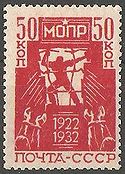 October RevolutionThe October Revolution , also known as the Great October Socialist Revolution , Red October, the October Uprising or the Bolshevik Revolution, was a political revolution and a part of the Russian Revolution of 1917...
October RevolutionThe October Revolution , also known as the Great October Socialist Revolution , Red October, the October Uprising or the Bolshevik Revolution, was a political revolution and a part of the Russian Revolution of 1917...
, which display strong elements of the style.
- Switzerland.

In 1932, Switzerland issued a stamp honoring the 1932 Disarmament Conference, and depicting an image of Peace in a bold Art Deco style
- Portugal.

In 1936, Portugal issued a series of airmail stamps with a highly stylized airplane propeller and cloud, forming a fine Art Deco image.
Latin America
The Art Deco style was popular with several Latin American countries, particularly Mexico, Chile and Brazil.- Mexico. Mexico issued some airmail stamps in the mid-1930s with lettering in a distinct Art Deco style. In 1939, Mexico issued a stamp with a boldly Art Deco image of the Arch of the Revolution, to commemorate the New York World's Fair
 1939 New York World's FairThe 1939–40 New York World's Fair, which covered the of Flushing Meadows-Corona Park , was the second largest American world's fair of all time, exceeded only by St. Louis's Louisiana Purchase Exposition of 1904. Many countries around the world participated in it, and over 44 million people...
1939 New York World's FairThe 1939–40 New York World's Fair, which covered the of Flushing Meadows-Corona Park , was the second largest American world's fair of all time, exceeded only by St. Louis's Louisiana Purchase Exposition of 1904. Many countries around the world participated in it, and over 44 million people...
.
In the early 1940s, Mexico issued a number of stamps, commonly a larger format with strongly Art Deco influenced images particularly including the artwork of Mexican artist Francisco Eppens
Francisco Eppens Helguera
Francisco Eppens Helguera or Francisco Eppens was a Mexican artist known for his paintings, murals and sculptures of images and scenes distinctly Mexican...
. A 1939 stamp with an image by Eppens depicted three modes of transportation -- airplane, train and highway, a common Art Deco subject. A 1940 stamp by Eppens shows a helmsman, issued in connection with the Inauguration of Mexican President Manuel Avila Camacho
Manuel Ávila Camacho
Manuel Ávila Camacho served as the President of Mexico from 1940 to 1946.Manuel Ávila was born in the city of Teziutlán, a small town in Puebla, to middle-class parents, Manuel Ávila Castillo and Eufrosina Camacho Bello. He had several siblings, among them sister María Jovita Ávila Camacho and...
. A 1942 stamp, part of a series honoring the Second Inter-American Agricultural Conference with Eppens' artwork, depicts a highly stylized woman sewing wheat.


- Chile. In the mid-1930s, Chile issued a series of airmail stamps designed in a style clearly influenced by Art Deco. These included a stylized airplane in flight following a radio navigation systemVHF omnidirectional rangeVOR, short for VHF omnidirectional radio range, is a type of radio navigation system for aircraft. A VOR ground station broadcasts a VHF radio composite signal including the station's identifier, voice , and navigation signal. The identifier is typically a two- or three-letter string in Morse code...
from point to point and a stylized condorCondorCondor is the name for two species of New World vultures, each in a monotypic genus. They are the largest flying land birds in the Western Hemisphere.They are:* The Andean Condor which inhabits the Andean mountains....
.


- Brazil.

During the 1930s, Brazil issued a number of stamps influenced by the Art Deco style, especially in their lettering. The most striking Art Deco stamps, however, was the 1934 issue commemorating the 7th International Trade Fair, held in Rio de Janeiro
Rio de Janeiro
Rio de Janeiro , commonly referred to simply as Rio, is the capital city of the State of Rio de Janeiro, the second largest city of Brazil, and the third largest metropolitan area and agglomeration in South America, boasting approximately 6.3 million people within the city proper, making it the 6th...
, and depicting silhouettes of buildings and a profile of a construction worker with highly stylized Art Deco lettering.
United States

1939 New York World's Fair
The 1939–40 New York World's Fair, which covered the of Flushing Meadows-Corona Park , was the second largest American world's fair of all time, exceeded only by St. Louis's Louisiana Purchase Exposition of 1904. Many countries around the world participated in it, and over 44 million people...
. Although the Trylon and Perisphere itself is an iconic Art Deco image, the lettering and numbers on the stamp were done in a traditional, not Art Deco, font. With this limited exception, United States stamps showed no Art Deco influence until 1998 when it issued a stamp in a strong Art Deco depicting Ayn Rand.
Revival


Ayn Rand
Ayn Rand was a Russian-American novelist, philosopher, playwright, and screenwriter. She is known for her two best-selling novels The Fountainhead and Atlas Shrugged and for developing a philosophical system she called Objectivism....
in a distinct Art Deco style. In 2001, it issued two definitive stamp
Definitive stamp
A definitive stamp is a postage stamp, that is part of a regular issue of a country's stamps available for sale by the postal service for an extended period of time...
s depicting a strongly Art Deco eagle on a mailbox, shown left. In 2003, it issued a stamp honoring Rockefeller Center
Rockefeller Center
Rockefeller Center is a complex of 19 commercial buildings covering between 48th and 51st streets in New York City, United States. Built by the Rockefeller family, it is located in the center of Midtown Manhattan, spanning the area between Fifth Avenue and Sixth Avenue. It was declared a National...
, shown right.

